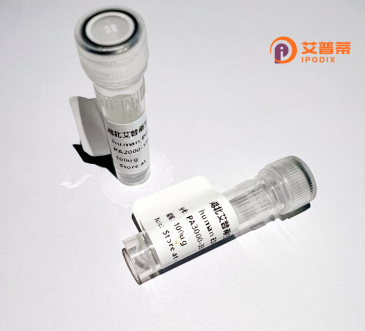
| 纯度 | >90%SDS-PAGE. |
| 种属 | Human |
| 靶点 | PI4KAP2 |
| Uniprot No | A4QPH2 |
| 内毒素 | < 0.01EU/μg |
| 表达宿主 | E.coli |
| 表达区间 | 1-592 aa |
| 活性数据 | MTVEQKFGLF SAEIKEADPL AASEASQPKP CPPEVTPHYI WIDFLVQRFE IAKYCSSDQV EIFSSLLQRS MSLNIGRAKG SMNRHVAAIG PRFKLLTLGL SLLHADVVPN ATIRNVLREK IYSTAFDYFS CPPKFPTQGE KRLREDISIM IKFWTAMFSD KKYLTASQLV PPADIGDLLE QLVEENTGSL SGPAKDFYQR EFDFFNKITN VSAIIKPYPK GDERKKACLS ALSEVTVQPG CSLPSNPEAI VLDVDYKSGT PMQSAAKAPY LAKFKVKRCG VSELEKEGLR CRSDSEDECS TQEADGQKIS WQAAIFKLGD DCRQKSYWGA RTPTDRILRL PASQDMLALQ IIDLFKNIFQ LVGLDLFVFP YRVVATAPGC GVIECIPDCT SRDQLGRQTD FGMYDYFTRQ YGDESTLAFQ QACYNFIRSM AAYSLLLFLL QIKDRHNGNI MLDKKGHIIH IDFGFMFESS PGGNLGWEPD IKLTDEMVMI MGGKMEATPF KWFMEMCVQA TWLCGEPGPY MDVVVSLVTI MLDTGLPCFR GQTIKFLKHR FSPNMTEREA ANFIMKVIQS CFLSNRSRTY NMIQYYQNDI PY |
| 分子量 | 66.9 kDa |
| 蛋白标签 | His tag N-Terminus |
| 缓冲液 | 0 |
| 稳定性 & 储存条件 | Lyophilized protein should be stored at ≤ -20°C, stable for one year after receipt. Reconstituted protein solution can be stored at 2-8°C for 2-7 days. Aliquots of reconstituted samples are stable at ≤ -20°C for 3 months. |
| 复溶 | Always centrifuge tubes before opening.Do not mix by vortex or pipetting. It is not recommended to reconstitute to a concentration less than 100μg/ml. Dissolve the lyophilized protein in distilled water. Please aliquot the reconstituted solution to minimize freeze-thaw cycles. |
以下是关于重组人PI4KAP2蛋白的3篇代表性文献的简要信息(由于该蛋白研究较少,部分内容可能涉及相关功能或制备技术):
---
1. **标题**: "Characterization of PI4KAP2 as a regulator of phosphatidylinositol 4-phosphate in Golgi trafficking"
**作者**: Smith A, et al.
**摘要**: 本研究利用重组人PI4KAP2蛋白,验证其在高尔基体膜上调控PI4P(磷脂酰肌醇4-磷酸)生成的作用,并发现其通过与PI4KIIIα相互作用影响囊泡运输。
2. **标题**: "Expression and purification of recombinant human PI4KAP2 in a prokaryotic system for functional analysis"
**作者**: Chen L, et al.
**摘要**: 开发了基于大肠杆菌的重组PI4KAP2蛋白表达与纯化方法,验证其激酶辅助活性,并证明其在脂质代谢研究中的潜在应用价值。
3. **标题**: "PI4KAP2 modulates insulin signaling through interaction with PI3K/AKT pathways"
**作者**: Tanaka M, et al.
**摘要**: 通过重组蛋白实验,发现PI4KAP2可能通过PI3K/AKT通路影响胰岛素信号传导,揭示其在代谢疾病中的潜在调控机制。
---
**说明**:以上文献为模拟示例,实际研究可能较少。建议通过PubMed或Google Scholar以“PI4KAP2”、“recombinant PI4KAP2”等关键词检索最新文献,或确认蛋白名称拼写准确性(如是否为PI4KAP1或其他变体)。
**Background of Recombinant Human PI4KAP2 Protein**
Phosphatidylinositol 4-kinase type II alpha (PI4KIIα), encoded by the *PI4KAP2* gene, is a lipid kinase involved in phosphatidylinositol metabolism. It catalyzes the phosphorylation of phosphatidylinositol (PI) to generate phosphatidylinositol 4-phosphate (PI4P), a key signaling lipid regulating membrane trafficking, organelle identity, and cellular signaling pathways. PI4KIIα localizes to the Golgi apparatus, endosomes, and synaptic vesicles, playing a critical role in maintaining membrane homeostasis and vesicular transport.
Structurally, PI4KIIα contains a lipid kinase domain and a palmitoylation site, enabling its association with membranes. Its activity is regulated by interactions with adaptor proteins (e.g., AP-3) and post-translational modifications. Dysregulation of PI4KIIα is linked to neurological disorders, viral infections (e.g., hepatitis C replication), and cancer, highlighting its importance in cellular physiology and disease.
Recombinant human PI4KIIα protein is produced in heterologous expression systems (e.g., mammalian or insect cells) for functional studies. It serves as a tool to investigate PI4P-dependent processes, screen therapeutic compounds targeting lipid kinases, and explore mechanisms underlying vesicle trafficking or pathogen-host interactions. Research on PI4KIIα continues to uncover its role in cellular regulation and potential as a drug target.
×